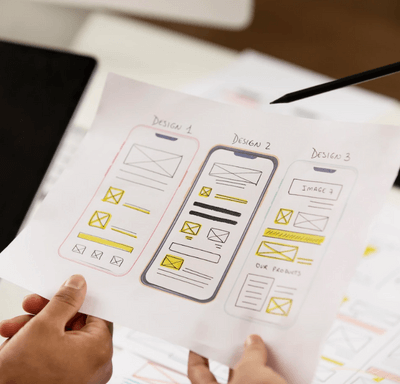
About us
Our Services
Our Expertise
Our Experience
Follow us
Why e2logy?
- We strive to provide superior customer service and ensure that every client is completely satisfied with our work.
- Our engineers are trustworthy, dedicated, and experienced and will go the extra mile to solve your IT issues.
- We are committed to delivering outstanding, cutting-edge IT solutions that add real value that goes beyond what is expected.

Mobile App Design Best Practices

There are many connected experiences in a mobile app. To make those experiences frictionless and cohesive, designers must be able to make them cohesive. It is not an easy task. There must be consistency across all screens when it comes to UI patterns and components. An intuitive interface must align with the goals of users. Guidelines for accessibility must be incorporated throughout the entire app.
An app’s success depends on uncovering the nuanced insights it needs through user research and testing. Mobile apps can be designed to delight and retain their users for a long time using widely applicable best practices.
A mobile app should follow the following best practices.
Content and services can be delivered through mobile apps in a trusted manner. A mobile app can be useful, relevant, and valuable for users, but how do you make it so in a crowded market?
To create a great mobile user experience, here are some best practices I have found to be essential.
1. Creating intuitive and useful experiences
Enhance the user’s experience by reducing the effort they have to put in. The information should be organized in such a way that obtaining the destination requires the fewest number of actions. Hide secondary actions and break large tasks up into smaller pieces. Using smart defaults, offloading tasks, allowing users to save a state, and allowing them to reengage later are all important features. Continuation is expected from where the user left off. Make sure the information is relevant to the user’s goals but not overwhelming.
2. Pay Attention to Notifications
You can use notifications to keep your users up-to-date on your app’s updates, new features, and the latest news. Users can quickly become overwhelmed by too many notifications and disable them altogether if they receive too many of them.
Keeping users’ attention by sending relevant notifications sparingly in 2023 will be the best practice for mobile app design.
If you plan to send notifications to your users, consider when and how you will do so when designing your app. Provide value to the user and make sure they are clear and concise. In addition, notifications may alert users to upcoming events or inform them of new features.
3. Maintain the same features on desktop and mobile
The rise of mobile web traffic has made it inevitable that users expect to be able to carry out the same tasks they can on their desktop computers on their mobile devices as well. Despite studies showing that most people prefer to use computers for complex tasks, 15% of Americans use smartphones exclusively for online access. Inadequate mobile banking apps, for example, can frustrate users and ultimately cause them to switch banks.
You can make the difference between good and bad app reviews by managing feature rollout expectations. For accurate expectations, create a publicly accessible feature roadmap if your app must be launched before all features are implemented.
4. Design with a minimal aesthetic
Minimalism has never been more popular. Distractions abound in today’s world. A user’s attention is hard to capture, and to do so you need a huge number of strategies and techniques. There is a desire for peace and calm even among the people. It would be hard for your mobile app to stand out if it had a lot of complicated design elements, along with lots of fluff. What feeling would the user have? Their problems will only get worse if you add to them.
Design user interfaces with minimal elements so that information can be easily consumed. Keep your navigation panel and bars hidden and use a lot of white space. Changing pages and categories is even easier with liquid swipes.
5. Ensure that the interface is finger-friendly
The temptation for UI/UX designers is to shrink elements when there’s not much screen space — but that’s not the best way to go. The elements should be large enough to be tapped (around 7 millimetres to 10 millimetres is ideal). Ensure that there aren’t too many buttons grouped together to prevent accidental hits by the user.
6. Secure and trustworthy from the beginning
You shouldn’t ask users to rate your app the first time they use it. If a user performs a task, don’t ask them to rate your app. Your app will be more likely to receive positive ratings and feedback from repeat users if you wait until they become repeat users. Transparent permission policies and the ability to control information sharing in mobile apps are important.
Establish credibility by displaying trusted security badges, especially when users entrust their financial and personal information to your brand.
7. Enhance the user experience
An important part of designing your app is optimizing user flow. A user’s journey through your app is called their user flow. Users must flow smoothly and intuitively. Design your app in such a way that users can finish their desired actions in as few steps as possible to optimize user flow. Your app should be designed so that users can easily book appointments, for example.
Using visual cues to guide users through your app is another way to optimize user flow. To indicate where users should go next, for instance, you can use arrows. Uber and Airbnb are two apps with successful user flow optimization. Users of both apps can complete their desired actions in a minimal number of steps with both apps. Visual cues are also used in both apps to guide users.
8. Provide full accessibility to your app
A neuromorphic design uses subtle shadows, gradient overlays, and monochromatic colours to render interface components. However, neuromorphic components’ monochromatic colours and low contrast make them challenging to view due to their tactile appearance and invitation to interact. The lack of accessibility to metamorphism also conflicts with the growing demand for inclusive digital products.
A company’s visual guidelines may not be compatible with neumorphic components because they are difficult to code. Be cautious when using neumorphic components, and ensure that your product is still accessible if you decide to use them.
9. Don’t miss a notification
Thousands of people uninstall apps each day due to annoying notifications, according to a report. Notification overkill results from sending too many push notifications in a short period, even if your app isn’t uninstalled.
Users who clear notifications without reading them have overkill notifications when they stop responding to the information they receive. Bundling your information into one notification can help you avoid this. It is important to provide relevant information. It should be sent when the users are awake and will be checking their phones.
10. Make your user interface less noisy
Software design from the 1990s was characterized by boxy user interfaces. Additionally, the style has too many lines, borders, and solid shapes, making the screen look too busy and hard to read.
It is still necessary to provide support structures for users so they can understand the visual hierarchy of the page. Err on the side of less, even if there’s no magic formula. Sparingly use solid backgrounds, lines, and drop shadows as supporting structures. When used properly, padding can be as effective as a line in making a complex composition stand out.
11. Display and hide passwords
Complex characters can be difficult to enter into password fields because of imprecise fingers and small screens. Sign-out actions should not be displayed upfront to keep people logged in. It is rare for users to enter passwords because of this.
Conclusion
In 2022, mobile app design best practices should be followed, according to our article. We must also take into account the usability of a mobile application as one of its main characteristics. You will see an increase in engagement if you implement these best practices since they will give your users a great user experience.
When it comes to digital engineering services, E2logy can lend you the services of some of its finest technology experts so that they can keep the users in mind during the development process. We will be happy to discuss your technology needs with you.













